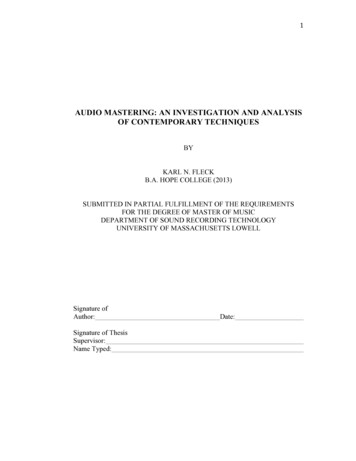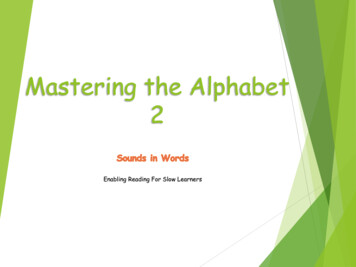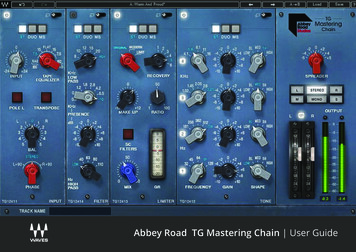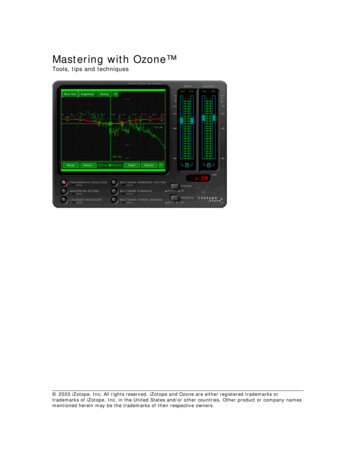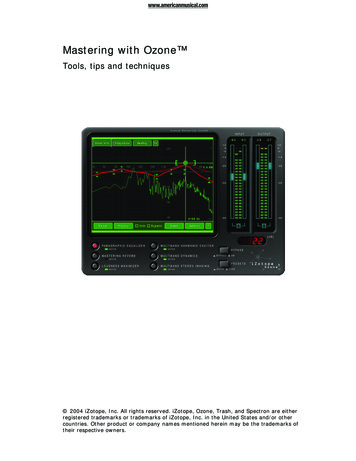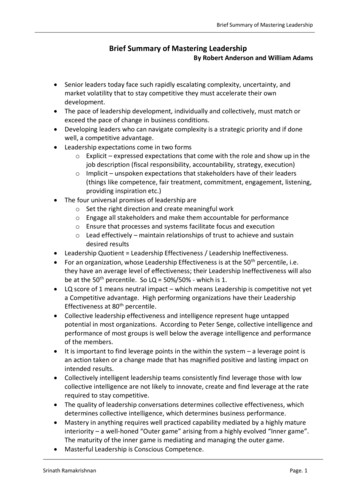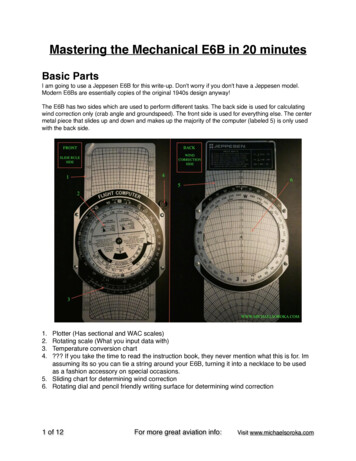
Transcription
!Mastering the Mechanical E6B in 20 minutes!Basic Parts!I am going to use a Jeppesen E6B for this write-up. Don't worry if you don't have a Jeppesen model.Modern E6Bs are essentially copies of the original 1940s design anyway!!!The E6B has two sides which are used to perform different tasks. The back side is used for calculatingwind correction only (crab angle and groundspeed). The front side is used for everything else. The centermetal piece that slides up and down and makes up the majority of the computer (labeled 5) is only usedwith the back side. !1.2.3.4.Plotter (Has sectional and WAC scales) !Rotating scale (What you input data with)!Temperature conversion chart!? If you take the time to read the instruction book, they never mention what this is for. Imassuming its so you can tie a string around your E6B, turning it into a necklace to be usedas a fashion accessory on special occasions. !5. Sliding chart for determining wind correction!6. Rotating dial and pencil friendly writing surface for determining wind correction!!!1 of 12For more great aviation info:Visit www.michaelsoroka.com
Getting started!!What you will need to use your E6B for:!!As a flight student, you will need to use your E6B to perform a couple of different calculations.These can be placed into the three different task groups as follows:!!1. Fuel, time, and distance calculations (Multiplication and division)!2. Wind correction - ie. Finding crab angle and ground speed (Trigonometry) !3. Other - Finding TAS, Density Altitude, converting units, ext. !!Each one of these three skill groups require a different technique to perform and can bepracticed independent of each other.!!1 - Fuel, Time, and Distance Calculations!!Fuel, time, and distance calculations are performed on the front side of the E6B. !!Becoming familiar with scales and pointers!!Before actually getting into some problems, you have to learn a little about the parts of the E6B.First I will define the scales and the pointers, and then I will show you how to put them intoaction. !Scales:!!The front side of the E6B is essentially acircular slide rule with three separatescales. These scales are named andhighlighted below:!!!SCALE A - The outer scale marked inred has a few purposes. It provides a wayto input and reference data with pointers(kind of like the buttons on a calculator).It is also where you will read allvariables except time. !SCALE B - The middle scale is used toread time in minutes or seconds. It canalso be used for multiplication anddivision. !SCALE C - The inner scale is only usedto determine time in hours!!2 of 12For more great aviation info:Visit www.michaelsoroka.com
!!Pointers: !!Pointers are the input method of the E6B.Different pointers will give you outputs indifferent units or bases. !!MULTIPLICATION AND DIVISION POINTERThis tiny pointer that extends from the centerof the “10” in a black box is used to performmultiplication and division problems like 5 7or 22 37.5. !SECOND POINTER - This little pointer abovethe “E” in SECONDS allows you work withseconds. It lies on the “36” because there are3600 seconds in one hour. !MINUTE/HOUR POINTER - This bigtriangular pointer is the most commonly usedpointer on the E6B. It allows you to work withminutes and hours or do anything in base 60. !!!!Now some problems:!!Ok, so now you are familiar with the three different scales on the E6B and the three differentpointers. Its time to put them to work!!!Multiplying and Dividing (Don’t skip)!!I decided to show how to multiply and divide on the E6B first. Even though these are not themost common operations the E6B is used for, it give you a good idea of how the “brain” on theE6B thinks. !!To multiply: !!Rotate the MULTIPLICATION AND DIVISION POINTER to place the number you want tomultiply with under Scale A. Then find the number you want to multiply by on Scale B. Readyour answer directly above this number on Scale A.!!Here’s an example:!!What is 9 9?!!!3 of 12For more great aviation info:Visit www.michaelsoroka.com
!Ok, I’m sure you have the 9 times tables memorized, but this is a great first problem to help youget used to the E6B. !!You will immediately notice that the E6B doesn't actually have a 9 on the A Scale or B Scale. Itinstead has the numbers 10-99 on it. One common feature of all slide rules, the E6B included, isthat they do not account for order of magnitude. This is a good thing and a bad thing. !!On the positive side, It means any number on the scale can represent any order of magnitude ofthat number. So, the 90 in the example above could be a 9, 90, 900, or 900,000,000. !!On the negative side, it means that you have to know the expected order of magnitude of youranswer. So, if I multiply 9 by 9, I need to know that the 81 output I receive is 81 and not 810, or810,000,000. Conversely, if I were multiplying 90 by 90, my answer would be 8,100. !!This will be a common theme for the rest of the problems. !!Now try a problem that’s a little harder to do mentally:!!22 35 ?!!!!!!!!4 of 12For more great aviation info:Visit www.michaelsoroka.com
Remember to apply proper order ofmagnitude. 22 35 is 770 not 77 or7700. !!I’m sure your thinking Wow! what ahandy tool. Now try an aviationrelated problem:!!On a cross country flight, you climbat 650 feet per minute for 7minutes. How much altitude did yougain?!!650fpm 7min 4550ft !!Again watch order of magnitude andapply logic as necessary. YourCessna probably gained more than45.5 feet but didn't zoom climb toFL450 in 7 minutes. As your E6Bskills improve, you will be able to doproblems like this much faster thanyou could with a calculator. !!!To divide:!!To divide with the E6B, use themultiplication technique in reverse:!!Rotate the wheel to align yournumerator on Scale A with yourdenominator on Scale B. Read youranswer at the MULTIPLICATION ANDDIVISION POINTER. (or simply putthe numerator over the denominatorand read off of the pointer)!!Ex: 15 3 ?!!Now try these division problems:!!60 25 ?!2.4!!!You need to descend 5,000ft in 7minutes. What descent rate will youneed?!5 of 12For more great aviation info:Visit www.michaelsoroka.com
5000 ft 7 min 715fpm (approximate) - The E6B can only handle two non-zero digits in itsanswer. The rest are approximated in the scale.!!Time between 2 points at a given ground speed (legtime)!!This is a common operation that needs to be done to fill out a Nav log or during a diversion inthe air.!!Typically, time is though of in seconds, minutes, and hours rather than percentage of hours(1:20 rather than 1.33 hours). Because this is a base 60 system, the multiplication pointer wontwork for most problems. !!Luckily, the E6B also has a Minute/hour pointer and a Second pointer.!!Before you start a leg time problem, you must first ask yourself: Is going to take hours, minutes,or seconds to get between these two points? This will tell you which scale and which pointer youwill need to use.!!Let’s start with minutes as it is the mostcommonly used time unit on Nav logs:!!Here’s the problem: At 110kts ground speed,how long will it take you to travel betweentwo checkpoints that are 18nm apart?!!Because it will take “minutes” to go betweenthese points, use the Minute/hour pointer.Point the Minute/hour pointer at the groundspeed. Find the distance on scale A, andread the answer off of Scale B directlyacross from the distance.!You will get an answer of 9.8 minutes!The nice thing about the mechanical E6B forthese types of problems is that it does not haveto be rotated again to calculate different legs ifthe ground speed is unchanged. This isespecially useful for filling out Nav logs andmakes the mechanical E6B much faster than itselectronic counterpart.!!It’s up to you to decide what you want to do with a number like this. Unfortunately, the E6B willnot return an answer in minutes and seconds. It only works in whole units for minutes. You caneither round your answer up or down (9.8 min to 10 min), or multiply the remainder by 6 toconvert to seconds (8 6 48 so 9:48)!!6 of 12For more great aviation info:Visit www.michaelsoroka.com
Hours between legs!!If you suspect it will take hoursbetween legs, the method is thesame except: You will still use theMinute/hour pointer, but will useScale C instead of scale B. !!Ex: How long will it take to fly320nm at a groundspeed of120kts?!!!!You should get 2:40!!!!!!!!!Leg time in seconds!!If you suspect it will take secondsbetween legs, the method is thesame except: You will use theSecond pointer instead of theMinute/hour pointer and will useScale B.!!Ex: How long will it take to fly1.2nm at 140kts!!!!!You should get about 31seconds.!!!!!!!7 of 12For more great aviation info:Visit www.michaelsoroka.com
Working in reverse to find ground speed and distance!!You can work in reverse to find ground speed for a known leg time and distance, and distancefor a known leg time and ground speed using the following methods:!!Groundspeed: Align the distance you traveled on Scale A with the time you traveled on eitherScale B for minutes or Scale C for hours. Read you groundspeed off of the pointer. !!Distance: Align the pointer with the groundspeed. Find the time on Scale B or Scale C forminutes or hours. Follow the time directly across to Scale A to get the distance traveled.!!Fuel for a given leg !!The procedure for determining fuel burn for a given leg is similar to finding leg time. Like legtime, the pointer and scales you use will be different if you are working with seconds, minutes,or hours. !!To calculate the fuel burned for minutes or hours of flight time, use the Minute/hour pointerand point to the the fuel burn in GPH. Find the leg time on either Scale B for minutes Scale Cfor hours. Read the fuel burned directly across on Scale A.!!For seconds, use the Second pointer and Scale B!!Ex: How much fuel will aCessna 152 burn on an 8minute leg with a fuel burnof 5.3 GPH?!!!!You should get around .71gallons.!!!!!!!!!!!8 of 12For more great aviation info:Visit www.michaelsoroka.com
2 - Crab Angle and Groundspeed Adjusted for Wind!!To find crab angle and groundspeed adjusted for wind, you will need to flip the E6B over to thebackside. !!You will also need a pencil!!On the backside of the E6B, youwill notice a rotating dial and ametal slider. The metal slider isreversible and has one side forlow speed aircraft (like lighttraining planes) and one side forhigh speed aircraft (like jets).Before getting started, make sureyou are using the correct side andthat your card is facing right-sideup. !!Now that you are oriented andhave your trusty pencil, you canbegin the process. Below are thesteps:!!For this example, I will use: !!True Airspeed of 125kts!True Course of 070!Winds from 290@22kts!!!!!!!!!1. Just like the Jeppesen instructions say, rotate the dial the place the wind direction under thetrue index (the little pointer on top).!!2. The instructions on the E6B are vague for step 2. The objective is to place a small pencilmark on the plastic pencil-friendly surface to identify the wind velocity. If you look down thecenter of the E6B, you will notice a bold center-line and some numbers from about 30 at thebottom to 260 at the top for the low speed card. You will also notice a grid which marksincrements of 2 units between the numbers. These numbers and the grid will be used toreference speed later. For now they will be used as a guide to mark the wind velocity. !!!!9 of 12For more great aviation info:Visit www.michaelsoroka.com
!!!!!! Place the small hole in the center of the plastic directly over the “100” mark. For now, the100 has no meaning other than to make it easy to count the wind units on the grid. ! Count the units upwards and place a mark on the plastic that corresponds to the windspeed. For example, for 22kts of wind, you would place the mark at “122”!3. Rotate the dial to place the true course under the true index.!4. Now slide the metal slider so that the pencil mark you made lines up with your groundspeed. In this example, this will mean that the mark will be left of the center-line. !5. Read the groundspeed corrected for wind at the center-line. In this example, the groundspeed is 141kts!6. Find the wind correction angle by counting the units between the pencil mark and thecenterline. In this example you will get about 6 degrees. If you pencil mark falls to the left ofthe centerline, subtract the value from your True Course to get your True Heading. If yourmark falls to the right add the value.!!!!!10 of 12For more great aviation info:Visit www.michaelsoroka.com
!So after all of that, youshould arrive at agroundspeed of 141ktsand a True Course of 64degrees.!!!!!!!!!!!!!3 - Other stuff (TAS, Density Altitude, andConversions)!!These problems will use the front side of the E6B!!TAS and Density Altitude!!Because the process for finding TAS and Density Altitude is the same, I have combined thesetwo tasks into one example.!!This process will use the Density Altitude window (center window) and Temperature/PressureAltitude window (right-most window) along with the A scale and B scale.!!To find TAS and Density Altitude, use the Temperature/Pressure Altitude window (right-mostwindow) and align your OAT on top with your Pressure Altitude on the bottom. ! Read your Density Altitude off of the pointer on the Density Altitude window (center window)! Find your CAS on the B scale. Your TAS is directly across on the A scale.!!Ex: What is the Density Altitude and TAS under the following conditions:!PA- 15,000’!OAT- minus 30c!CAS- 150kts !!!11 of 12For more great aviation info:Visit www.michaelsoroka.com
You should get13,000’ and184kts!!!Conversions(below)!!The E6B can doa bunch ofconversions.Rather thanoutline each one,I have made acollage of sorts tohighlight a couple!Hope this helps!!!Remember, practice makes perfect. Im sure over time, you will find the E6B to be faster can acalculator.12 of 12For more great aviation info:Visit www.michaelsoroka.com
Mastering the Mechanical E6B in 20 minutes!! Basic Parts! I am going to use a Jeppesen E6B for this write-up. Don't worry if you don't have a Jeppesen model. Modern E6Bs are essentially copies of the original 1940s design anyway!!! The E6B has two sides which are used to perfo
